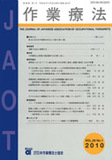Japanese
English
- 販売していません
- Abstract 文献概要
- 1ページ目 Look Inside
- 参考文献 Reference
要旨:手工芸活動は統合失調症患者を対象とした作業療法で用いられている.手工芸の教授方法の違いによる脳活動の違いを明らかにするため,近赤外分光法を用いて麻紐編みの編み方思考時の脳活動を計測した.健常成人8名を対象とし,麻紐の完成見本のみを提示した試行錯誤課題と,編み方手順を説明した手ほどき課題の前頭前野の活動領域を比較した.結果,手ほどき課題時は試行錯誤課題時に比べ,より広範囲の脳活動(有意なオキシヘモグロビン濃度長の増加)が認められた.手工芸の教授時に作り方の手順を示すことが,試行錯誤させるよりも広範囲に脳を賦活させ,統合失調症患者にみられる前頭前野の血流低下の改善に影響を与えることが示唆された.
Craft activities are used as an occupational therapy treatment for schizophrenic patients. In the present study, near-infrared spectroscopy was used to examine activity in the prefrontal cortex resulting from different instructions for learning a handicraft (hemp knitting). Eight healthy subjects were required to think about how to knit (thinking condition) and were taught how to knit by an occupational therapist (learning condition). The extent of activity in the prefrontal cortex between the two conditions was compared. Widespread activity (significant increase in concentration of oxygenated hemoglobin) was observed during the learning condition, while less activity was observed in the thinking condition. These findings indicate that appropriate instructions activate widespread areas in the prefrontal cortex, which may improve a hypofrontality in schizophrenic patients.

Copyright © 2010, Japanese Association of Occupational Therapists. All rights reserved.


